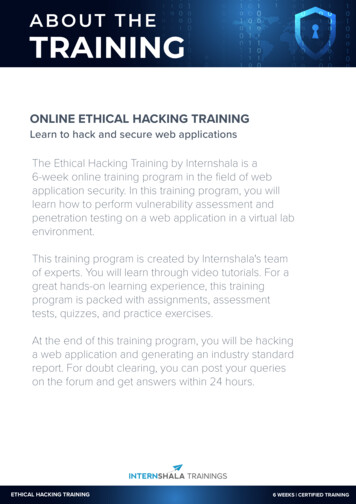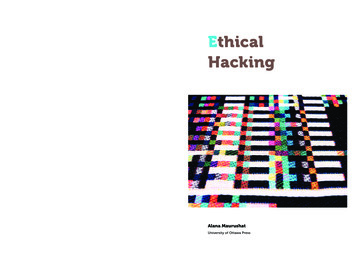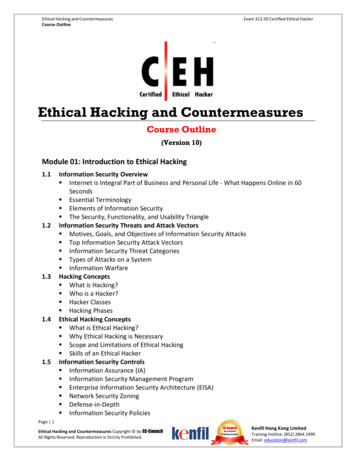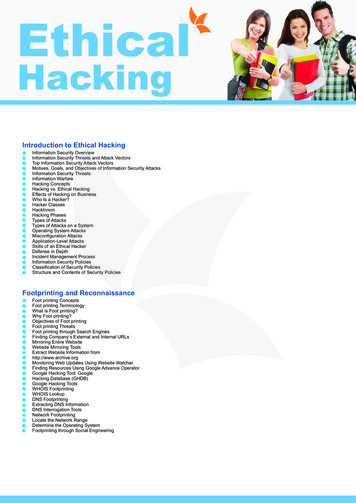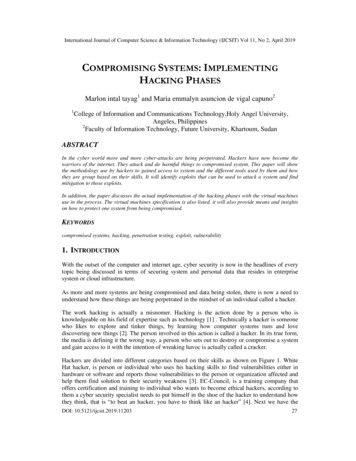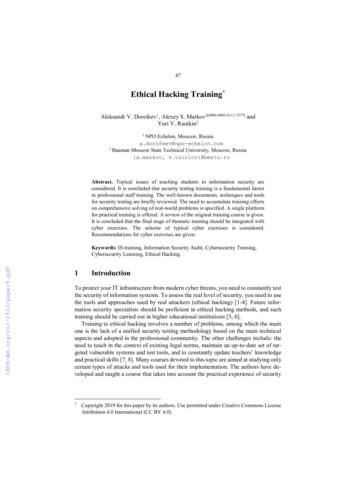
Transcription
47Ethical Hacking Training*Aleksandr V. Dorofeev1, Alexey S. Markov2[0000-0003-0111-7377] andYuri V. Rautkin21 NPO Echelon, Moscow, Russiaa.dorofeev@npo-echelon.com2 Bauman Moscow State Technical University, Moscow, Russia{a.markov, v.tsirlov}@bmstu.ruAbstract. Topical issues of teaching students to information security areconsidered. It is concluded that security testing training is a fundamental factorin professional staff training. The well-known documents, techniques and toolsfor security testing are briefly reviewed. The need to accumulate training effortson comprehensive solving of real-world problems is specified. A single platformfor practical training is offered. A review of the original training course is given.It is concluded that the final stage of thematic training should be integrated withcyber exercises. The scheme of typical cyber exercises is considered.Recommendations for cyber exercises are given.Keywords: IS-training, Information Security Audit, Cybersecurity Training,Cybersecurity Learning, Ethical Hacking.1IntroductionTo protect your IT infrastructure from modern cyber threats, you need to constantly testthe security of information systems. To assess the real level of security, you need to usethe tools and approaches used by real attackers (ethical hacking) [1-4]. Future information security specialists should be proficient in ethical hacking methods, and suchtraining should be carried out in higher educational institutions [5, 6].Training to ethical hacking involves a number of problems, among which the mainone is the lack of a unified security testing methodology based on the main technicalaspects and adopted in the professional community. The other challenges include: theneed to teach in the context of existing legal norms, maintain an up-to-date set of targeted vulnerable systems and test tools, and to constantly update teachers’ knowledgeand practical skills [7, 8]. Many courses devoted to this topic are aimed at studying onlycertain types of attacks and tools used for their implementation. The authors have developed and taught a course that takes into account the practical experience of security*Copyright 2019 for this paper by its authors. Use permitted under Creative Commons LicenseAttribution 4.0 International (CC BY 4.0).
48testing projects to the maximum extent possible, which made it possible to focus teaching not only on the tools, but also on the methodology of comprehensive testing ofinformation systems security.2Security Testing MethodologyIt is obvious that the methodology of comprehensive security testing should include adescription of the project phases and methods of conducting specific technical checks.Regarding how to structure the phases of the security testing project, there are generally accepted methods, governed by such documents as: NSA IEM, NIST SP 800115, BSI Penetration Testing Model [7-9]. The sequence of stages of the security testingproject can be presented as follows: Determining the scope of the project;Collecting information about systems;Planning of specific checks;Performing checks;Analysis of the data received;Preparation of a report and formation of recommendations.As to specific checks, it is worth paying attention to the presence of at least threeconceptual approaches [10-13]:A classic penetration test, which is the search and exploitation of the most dangerousvulnerabilities to demonstrate the possibility of hacking systems. The main advantageof the approach is detection of real attack vectors, and the main disadvantage is potential violating of the availability of services and systems.Vulnerabilities scanning. Vulnerabilities scanning uses special software – vulnerability scanners. The scanner determines the versions of network services and checks toensure that information about the published vulnerabilities is available in its constantlyupdated database. The main advantage is a high audit speed, the main disadvantage is“linear” logic of the scanner and inability to detect non-trivial attack vectors.Configuration analysis. During the system configuration analysis, various systemsecurity settings are checked, for example, password policy, access rights to systemresources, availability of installed updates etc. The main advantage is the possibility offinding vulnerabilities associated not only with errors in software development, but alsobecause of errors made during administration.The methods of specific technical checks should also be based on hacking methodsused by real attackers. A potential sequence of their actions is shown in Fig. 1.
49Fig. 1. Typical sequence of attacker’s actions.Analysis of the possibility of combining the well-known security testing methodsand hacker approaches has allowed us to formulate a common integration testing methodology, which includes the following steps: Inventory of resources/search for testing goals;Vulnerability search (manual search, scanning, configuration analysis);Exploiting vulnerabilities and conducting attacks (penetration testing);Expansion of access (see Fig. 2).The advantages of this approach are as follows [14, 15]: Identifying the maximum number of vulnerabilities and non-trivial attack vectors; Controlled risks of system malfunctions; Verification of vulnerabilities.
50Fig. 2. Stages of comprehensive security testing.3Ethical Hacker ToolkitBased on the practice of security testing projects, the following list of necessary toolscan be generated: Port scanners;Vulnerability scanners;Web vulnerability scanners;Penetration testing frameworks, including exploit kits;Password guessing tools based on hash values obtained;Password guessing tools for network services;Network sniffers;utilities for Man-in-the-Middle attacks (for example, ARP-poisoning);Utilities to test wireless networks etc.It should be noted that such a common class of security analysis tools as vulnerabilityscanners is just a small part of the complete set of tools of an ethical hacking specialist.To implement a set of checks, Kali Linux environment is often used to launch a setof unix utilities. Unfortunately, its disadvantage is the absence of a unified report and afriendly shell focused on different levels of training and privileges of specialists [1619]. These shortcomings can be eliminated by using the certified security analysiscomplex “Scanner-VS” [20], which allows you to perform the full scope of checksrequired from the uniform environment, taking into account the level of user training,
51and to receive a unified report on the comprehensive audit of the system and networksafety etc.4Training Course StructureBased on a comprehensive approach to security, we have developed the structure ofour training course, including the following 8 sections: Chapter 1. Introduction to the penetration testing.Chapter 2. Intelligence Gathering.Chapter 3. Vulnerability Analysis.Chapter 4. Exploitation.Chapter 5. Exploitation of Web-applications.Chapter 6. Social engineering.Chapter 7. Maintaining access.55.1Description of the Training Course SectionsIntroduction to the Penetration TestingIn the very first section of the course, students get acquainted with the basic concepts(vulnerability, APT, exploit, payload etc.), comprehensive testing methods,documenting penetration testing results. This section of the course examines thestructure of the penetration test report: the chapters “Summary for Management”,“Project Scope” and chapters with descriptions of detected vulnerabilities. Thedescriptions of vulnerabilities contain subsections: finding – risk – recommendation[14]. The “finding” subsection describes what kind of vulnerability has been detectedand in which system, and demonstrates the possibility of its exploitation withappropriate screenshots. The “risk” subsection describes the situation that can occur ifpotential attackers exploit this vulnerability. For the proper assessment, testers need tofind out the criticality of the compromised resource. In the “recommendation”subsection, security testing experts give advice on how to correct the situation.Throughout all other sections of the course, students develop and supplement thereport on vulnerabilities detected in the course of laboratory work.5.2. Intelligence GatheringThis section analyses methods of collecting and analysing information to identify thepurposes for which security testing will be conducted. Students perform laboratorywork to find network nodes on the Internet related to a particular organization (usingwhois service, various queries to DNS servers), as well as to identify nodes duringinternal security testing (scanning of network ports, tracing of network routes). Thissection also teaches to Structured Analysis Techniques, which are used for efficient
52information retrieval [21]. It also considers the use of search engine operators for thetargeted information retrieval on the Internet.5.3. Vulnerability AnalysisThe third section of the course covers two approaches to vulnerability search: manualand automated (using vulnerability scanners) search [15].Manual search for vulnerabilities involves determining the software version and thelist of vulnerabilities known for this version of the product. You can find out the versionof the software product in a number of ways. For example, many network services,when accessing them, demonstrate a so-called banner containing version data.Sometimes the version can be determined analytically. For example, you can find apress release of a developer or integrator company that created an Internet portal to behacked by an attacker. The press release often contains all the necessary informationabout the technologies used, and comparing the release date of this news with theinformation about the release dates of the corresponding product allows you to easilydetermine which versions were used. Performing the appropriate laboratory work,students master the methods of analysis and comparison of data obtained usingtechniques mastered in the previous section of the course (port scanning and search forinformation on the Internet).Vulnerability search can be automated using special vulnerability scanners. Studentsperform laboratory work to search for vulnerabilities using a vulnerability scanner,learn how to choose and form scanning policies correctly, as well as apply scanningmodes with and without an administrative account. An equally important skill that isdeveloped within the framework of this section is the ability to interpret scanningresults.5.4. ExploitationIn the fourth section of the course students learn techniques of exploitingvulnerabilities, as well as a number of common attacks. Metasploit Framework is usedas the main tool for exploiting vulnerabilities in the laboratory [22, 23]. In addition toexploiting vulnerabilities, students learn such attack methods as password guessing andtraffic interception using ARP-poisoning.Students gain practical experience in both bruteforce and dictionary attacks. In thefirst case, passwords are generated based on the set rules [24, 25]. Dictionary attacksallow you to try your luck and check if the user is using a common password. Recentpassword leaks clearly show that many users prefer to choose keyboard passwords(such as qwerty, qazwsxedc), phone numbers, dates, names etc. Students learn how tocreate password dictionaries using analytical methods.5.5. Exploitation of Web-applicationsExploitation of vulnerabilities in web applications is considered in a separate section.The main attacks related to web applications are considered: Cross Site Scripting - CSSand SQL injection. In the case of CSS, the script is implemented on the website pages,
53which is executed in the user’s browser when viewing the page. This can happen, forexample, due to an error of the programmer, who did not implement the correct filteringof data entered by the user, for example, when a user posts a message on the forum.SQL injection consists in the fact that due to an error in the data filtering or webapplication architecture, an attacker can directly interact with the application databasevia SQL commands through the web interface.5.6. Social EngineeringThe sixth section of the course addresses social engineering techniques aimed atprovoking users to take actions that are beneficial for attackers. In the course oflaboratory work, students learn phishing attack techniques and exploitation methods forvulnerabilities in the application software used by users.5.7. Maintaining AccessThe final section of the course is devoted to expanding the zone of influence andmaintaining comfortable access to the infrastructure under test, simulating similaractions by attackers.Expansion of the zone of influence is discussed using the following two examples.In the course of the laboratory work, students gain access to a web server at theoperating system level. This access allows them to find configuration files of webapplications running on the server and extract passwords from them to access databaseshosted on other servers. The second example is related to obtaining user passwords andverifying their validity to other systems deployed in the test infrastructure.In the laboratory work, devoted to creating comfortable access to the target system,students learn how to implement a backdoor in the installation deb package based onMetasploit Framework components.6Description of a Vulnerable Training SystemThe course uses a specialized Linux build, containing vulnerable network services,Metasploitable 2. Metasploitable 2 contains more than 200 vulnerabilities in suchservices as FTP server, Web server, Postgres, MySQL, IRC, VNC etc. The build alsocontains vulnerable Web applications like DVWA.7Ethical Hacking Development: Cyber ExercisesThe next step in ethical hacking development is cyber exercises involving creation of avirtual infrastructure to be protected by one team of students and to be attacked by theother. Let us look at Locked Shields drills conducted by the NATO Cooperative CyberDefence Centre of Excellence as open examples of such cyber exercises.Let us start with Locked Shields cyber drills that were conducted in 2013. Theorganizers of the exercises have created a virtual infrastructure that includes about 400
54nodes. The infrastructure is called Gamenet. Each team of defenders (Blue team)received a network of 34 machines, including a router, firewalls, Linux and Windowsworkstations, domain controllers, file, mail, DNS and web servers, and databaseservers.It should be noted that the protected systems were as close to the reality as possible,and the organizers of exercises prepared the following points: A few patches were missing on the operating systems, the application software wasmainly vulnerable; Two backdoors were introduced in advance, which started to access the managementservers at the appointed time; The network had a connected vulnerable laptop of the contractor’s specialist.Each protected infrastructure was also accessed by a representative of the organizingteam (White Team), who acted as a “blonde”, imitating a curious user who clicks on allthe links in the emails received and opens all attachments.The attackers (Red Team) were armed with full knowledge of the target ITinfrastructure, as well as the tools used during the cyber attacks: Kali Linux andMetasploit. Attackers were divided into groups by the following specializations:workstations, Web and DBMS, networks etc. The team of “Reds” was assigned 20tasks, which had to be performed in stages during the exercise. Examples of tasks: tochange the content of an important Web page, organize denial of service, getadministrative access, introduce malicious code, get access to certain emails, receive aspecific report, replace a video file etc. The duration of the active phase of the exercisewas 3 days.Such cyber exercises following the ethical hacking course will help to consolidatethe acquired skills of security testing in practice.8ConclusionThe main factors of successful training of students in ethical hacking are the following:the availability of methods, an appropriate set of vulnerable systems and tools forsecurity testing. In our opinion, we have managed to create a practical course on ethicalhacking, which allows students to master the key skills required by information securityspecialists. Cyber exercises are the logical continuation of such training, which is thesubject of our further research.The proposed training course and the support platform were tested for a long time inthe Echelon training course, as well as in the framework of the international thematicOlympiad-contest Echelon Defence.
55References1. Lane, E.: Hacking with Python: Beginner's Guide to Ethical Hacking, Basic Security,Penetration Testing, and Python Hacking. CreateSpace Independent Publishing Platform(2017).2. Petrenko, A.S., Petrenko, S.A., Makoveichuk, K.A., Chetyrbok, P.V.: Protection Model ofPCS of Subway from Attacks Type «Wanna cry», «Petya» and «Bad rabbit» IoT. In:Proceedings of the 2018 IEEE Conference of Russian Young Researchers in Electrical andElectronic Engineering (ElConRus 2018). IEEE, pp. 945 – 949 (2018). DOI:10.1109/EIConRus.2018.8317245.3. Thompsons, J.: Hacking: Hacking For Beginners Guide On How To Hack, ComputerHacking, And The Basics Of Ethical Hacking. CreateSpace Independent PublishingPlatform (2017).4. Walker, M.: CEH Certified Ethical Hacker All-in-One Exam Guide: 3rd Ed. McGraw-HillEducation (2016). 525 p.5. Petrenko, S.A., Petrenko, A.S., Makoveichuk, K.A.: Problem of Developing an EarlyWarning Cybersecurity System for Critically Important Governmental Information Assets.In: CEUR Workshop Proceedings. 2081, pp. 112-117 (2017).6. Sheremet, I.A.: Directions of a New Level Education to Counter Cyberthreats in FinancialSphere. Voprosy kiberbezopasnosti [Cybersecurity issues]. 4, pp. 69-74 (2017). DOI:10.21681/2311-3456-2016-5-3-7.7. BSI - Study A Penetration Testing Model. A Penetration Testing Modul. I/Publications/Studies/Penetration/penetration pdf.pdf, last accessed 2019/08/08.8. Rogers, R., Fuller, E., Miles, G., Hoagberg, M., Schack, T., Dykstra, T., Cunningham, B.,Little, C.: Network Security Evaluation Using the NSA IEM. Syngress (2005).9. Scarfone, K., Souppaya, M., Cody, A., Orebaugh, A.: Technical Guide to InformationSecurity Testing and Assessment. NIST. SP 800-115, pp. 1-80 (2008). DOI:10.6028/NIST.SP.800-115.10. Allsopp, W.: Advanced Penetration Testing: Hacking the World's Most Secure Networks.John Wiley & Sons (2017).11. Dorofeev, A.V., Rautkin, Y.V. Applied Aspects of Security Testing. In: CEUR WorkshopProceedings. 2081, pp. 49-53 (2017).12. Kim, P.: The Hacker Playbook 2: Practical Guide to Penetration Testing. CreateSpaceIndependent Publishing Platform (2015).13. Shatob, R.: Step by Step Guide to Penetration Testing. Tellwell Talent (2019).14. Markov, A., Barabanov, A., Tsirlov, V.: Models for Testing Modifiable Systems. In Book:Probabilistic Modeling in System Engineering, by ed. A.Kostogryzov. IntechOpen. Chapter7, pp. 147-168 (2018). DOI: 10.5772/intechopen.75126.15. Markov, A.S., Fadin, A.A., Tsirlov, V.L.: Multilevel Metamodel for Heuristic Search ofVulnerabilities in The Software Source Code. International Journal of Control Theory andApplications. 9, 30, pp. 313-320 (2016).16. Dieterle, D.W.: Basic Security Testing with Kali Linux 2. CreateSpace IndependentPublishing Platform (2016).17. Hertzog K., O'Gorman J.: Kali Linux Revealed: Mastering the Penetration TestingDistribution. Offsec Press (2017).18. Schultz, C.P., Perciaccante, B.: Kali Linux Cookbook: Effective penetration testingsolutions: 2nd Ed. Packt Publishing (2017).
5619. White, A.K.: Hacking: The Underground Guide to Computer Hacking, Including WirelessNetworks, Security, Windows, Kali Linux and Penetration Testing. CreateSpaceIndependent Publishing Platform (2017).20. Scaner-VS. NPO Echelon, http://scaner-vs.ru/trial, last accessed 2019/08/08.21. Dorofeev, A.V., Markov, A.S., Tsirlov, V.L.: Social Media in Identifying Threats to EnsureSafe Life in a Modern City. Communications in Computer and Information Science. 674,pp. 441-449 (2016). DOI: 10.1007/978-3-319-49700-6 44.22. Heriyanto, T., Allen, L., Ali, S.: Assuring Security by Penetration Testing. Packt Publishing(2014).23. Jaswal, N.: Metasploit Bootcamp: The fastest way to learn Metasploit Paperback. PacktPublishing (2017).24. Markov, G., Sharunov, V.: Mail Service Password Security. In: CEUR WorkshopProceedings. 2081, pp. 79-82 (2017).Picolet, J. Hash Crack: Password Cracking Manual. CreateSpace Independent PublishingPlatform (2017).
47 Ethical Hacking Training* Aleksandr V. Dorofeev1, Alexey S. Markov2[0000-0003-0111-7377] and Yuri V. Rautkin2 1 NPO Echelon, Moscow, Russia a.dorofeev@npo-echelon.com 2 Bauman Moscow State Technical University, Moscow, Russia {a.markov, v.tsirlov}@bmstu.ru Abstract. Topical issues of teaching students to information security are


